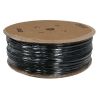YSI Amazon Bubbler
Features
- Integrated data logger for standalone applications with optional menu display
- Can be used as a sensor connected to other recorder devises; data logger, PLC, RTU, etc.
- Browser-based GUI is compatible with standard web browsers on PCs, tablets & smartphones
- Expedited repair and warranty service
- Lifetime technical support
- More
Overview
Designed with simplicity in mind, the YSI Amazon Bubbler is the ideal system for long-term, water level monitoring sites. It can be used as a stand-alone system with internal data storage, or as a sensor connected to any data logger. Easily configure and collect data using the browser-based graphical user interface with all standard web browsers on PCs, tablets and smartphones. Its rugged build and technologically advanced system make the Amazon Bubbler an attractive solution for real-time monitoring and data collection.
Continuous Operation
The YSI Amazon Bubbler provides a continuous air bubble and an integrated pressure sensor that measures the pressure required to push the bubble out of the orifice line, which is the line pressure. The line pressure value measured in psi is then converted into the desired units of measurement to represent water level.
Compatible
YSI Amazon Bubbler can be used as a stand-alone unit or sensor with a full suite of communication protocols, including SDI-12, MODBUS via RS-485 or TCP, and 4-20mA. The Amazon requires no special software and is easily configured with an optional display and or web browser GUI.
In The News
Monitoring Mariculture in the Gulf of Alaska
The mariculture industry in the Gulf of Alaska has been steadily growing in recent years, guided by ongoing research to help refine farm location and cultivation practices. A subset of aquaculture, mariculture focuses on rearing organisms in the open ocean. In Alaska, finfish farming is illegal, so most farms cultivate kelp, oysters, or a combination of the two. These small, locally operated farms started popping up in the Gulf of Alaska in the early 1990s, when shellfish farming first became legal. Kelp farming did not begin to catch on in the state until 2016. Many of the coastal areas that have grown interested in mariculture are historically commercial fishing communities.
Read MoreSupplying Seattle’s Drinking Water: Using Data Buoys to Monitor the Cedar River Municipal Watershed
Providing clean, safe, and reliable drinking water for the 1.6 million people in the greater Seattle area is a top priority for Seattle Public Utilities (SPU). With limited water supplies, SPU dedicates considerable resources to maintain its watersheds and mountain reservoirs. About 70 percent of Seattle Water comes from the Cedar River Municipal Watershed , and the other 30 percent comes from the South Fork Tolt River Watershed . [caption id="attachment_39574" align="alignnone" width="940"] Data buoy in Chester Morse Lake . (Credit: Kevin Johnson / Seattle Public Utilities) [/caption] Jamie Thompson, a fisheries biologist at SPU, monitors aquatic ecosystems centered on fish listed under the U.S. Endangered Species Act (ESA).
Read MoreData-Driven Advocacy on the Lower Deschutes River
Like many freshwater environments, the Deschutes River in Oregon is under pressure from development, pollution, and climate change. Many rivers, streams and lakes in the Deschutes Basin do not meet Oregon water quality standards –where state water quality monitoring assesses levels of bacteria, pH, dissolved oxygen, temperature, and fine sediment. Hannah Camel is the Water Quality Coordinator for the Deschutes River Alliance (DRA), a non-profit organization that focuses on the health of the lower 100 miles of the Deschutes River–the area most affected by human intervention. As a data-driven organization, the DRA has benefited from the installation of two NexSens X2 data loggers.
Read More













